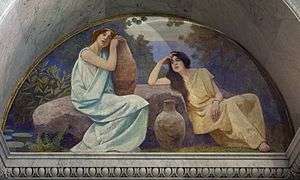Lunette


In architecture, a lunette (French lunette, "little moon") is a half-moon shaped space, either filled with recessed masonry or void. A lunette is formed when a horizontal cornice transects a round-headed arch at the level of the imposts, where the arch springs. If a door is set within a round-headed arch, the space within the arch above the door, masonry or glass, is a lunette. If the door is a major access, and the lunette above is massive and deeply set, it may be called a tympanum.
The term is usefully employed to describe the section of interior wall between the curves of a vault and its springing line. A system of intersecting vaults produces lunettes on the wall surfaces above a cornice. The lunettes in the structure of the Sistine Chapel inspired Michelangelo to come up with inventive compositions for the spaces.
In neoclassical architecture of Robert Adam and his French contemporaries, like Ange-Jacques Gabriel, a favorite scheme set a series of windows within shallow blind arches. The lunettes above lent themselves to radiating motifs: a sunburst of bellflower husks, radiating fluting, a low vase of flowers, etc.
A lunette may also be segmental, and the arch may be an arc taken from an oval. The spaces are still lunettes.
A lunette is commonly called a half-moon window, when the space is used as a window.
See also
External links
-
 Media related to Lunettes at Wikimedia Commons
Media related to Lunettes at Wikimedia Commons